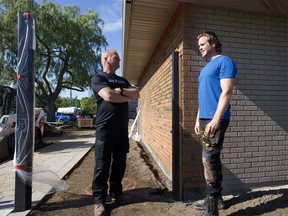
Article content
You’ve often heard me say, protect your home from the outside in. The primary components of your home’s defense against wind, rain, snow, and extreme heat are its roof and exterior. Your environment significantly influences the kind of siding you choose for your house.
Advertisement 2
Article content
By replacing the siding with new material, you can increase the value of your property and improve the curb appeal, all while extending the lifespan of your home. It’s also a great time to add extra insulation to help save on energy costs.
Whatever the choice of material, it is essential to use a waterproof barrier and flashing around the windows and doors. Before calling a contractor, spend some time researching your other options and deciding which would best fit your property.
Brick is one of the most common types of siding. It’s durable, weather resistant, and looks great. However, brick is porous, so you must have the proper vapor barrier or air barrier between the substrate and the brick to prevent water damage, plus regular maintenance with the occasional repointing. Brick is not ideal for coastal regions, as salt can weaken and erode the brick over time.
Brick staining is another great way to update your house. Staining allows you to make subtle or dramatic changes to your brickwork, and adding masonry strengthener will help restore your old brick. Staining allows the brick to breathe while giving it new life. It can transform your home, lasting up to 30 years, and increase curb appeal without moving. It is also a good option if you have added new brick, for example by making a window smaller. You can stain your new bricks to match the existing ones.
Stucco, with the proper application, is another excellent option. Stucco’s most significant benefit is its resistance to termite infestation, fire, rot, and mildew. However, choose a stucco installation that includes a drainage and insulation system to prevent water from hitting the substrate material. Leave an eight-inch gap between the ground and your stucco (in fact, all exterior siding) to allow for snow buildup and to avoid moisture from getting into the stucco. Crumbling and cracking might be signs of moisture buildup, which requires immediate attention.
Advertisement 3
Article content
Fiber-cement siding is made of sand, cement, and cellulose fibers and makes a great all-purpose option. Fiber-cement walled homes are more resistant to humidity and salt air if you live in a coastal region. It protects against cracking and is insect and fire-resistant even if you are not close to any water. It prevents heat transmission from your home, making it perfect for hot and cold regions. However, installation should be performed by a skilled professional because the material is heavy, difficult to cut, and expensive.
Wood is one of the oldest and most versatile sidings and can come as shingles, clapboards, board-and-batten panels, or tongue-and-groove planks. It is affordable, simple to install, made from a renewable resource, and looks great. However, unless you pick cedar or redwood, which are innately resistant to pests and the environment, it does require painting or staining every three to four years. Engineered wood siding is another option; though expensive, it lasts a long time with little upkeep. I love it.
Vinyl siding is also a great option and comes in various colors and finishes. No matter the environment, good-quality vinyl siding should last. Cheaper vinyl may not perform as well with fluctuating temperatures resulting in buckling and cracking. To prevent buckling, ensure your installers allow some breathing area, about 14 inches between the nail heads and the siding. Also, have your installer add a layer of foam sheathing and, of course, a moisture barrier. Insulated vinyl solutions will also shield against wind, rain, and snow and raise the R-value of your home; and is excellent for colder regions.
Advertisement 4
Article content
Another excellent exterior material is spray cork. I love it. It is a spray-on coating made from cork that can be applied to any surface, including wood, brick, stucco, and aluminum siding. Spray cork can enhance your home’s exterior, come in many colours, and forms a natural thermal barrier as it expands and contracts with the climate. Plus, it is fire and water-resistant and made of natural and renewable resources. It can also save anywhere from 10 to 50 per cent on your energy costs.
The performance of your siding or outside envelope depends significantly on how well it is installed, and if done poorly, it can lead to rot and mold. To prevent this, ensure a waterproof barrier is installed over the sheathing and flashing around windows and doors.
I’ve been telling people for years that you’ve got to build according to the environment. Building needs will vary according to the region, and if you build with that in mind, you’ll have a home that’s safe, strong, and built to last.